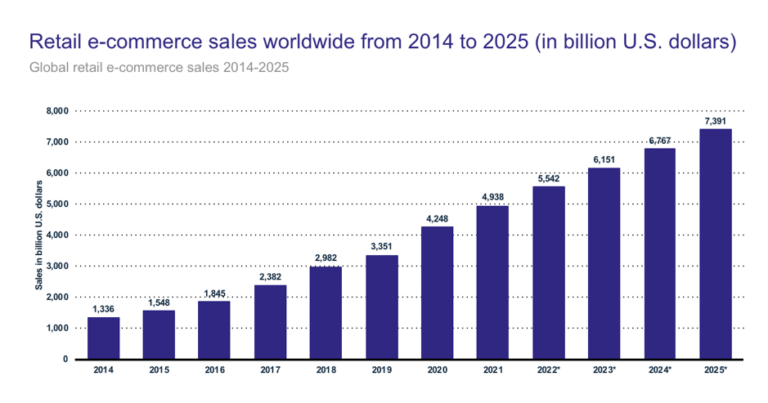This article will be the opening article to the series “How to start an eCommerce business in the UK,” which will include an overview of the steps to launch your business. The sub-articles to follow in this series will delve deeper into each step along the journey – which will be shared over the next 8 weeks. Sign up here to get notified of the next release.
Now let’s get started…
eCommerce was once considered a luxury when many people, including myself, preferred to get their shopping done in person by visiting high street stores. When COVID-19 hit, many norms changed, including the way we shop. Moreover, some high street shops that were once our favorites closed and might never open again. While hundreds of eCommerce businesses have been opening over the past few months worldwide. In addition, startups in this space have been creative in shaping the new era of shopping. This includes features such as the “Try it at Home” or “Buy Now, Pay Later” that have made eCommerce more popular or even the norm.
According to a study done by Statista, eCommerce sales are expect to grow at a CAGR of 8.4% in the next 4 years. The figure below shows the estimated sales for eCommerce in the next few years. Although we believe 2023 will have lower sales than shown in the figure below due to the upcoming recession, the overall market remains upward.
Do you want to know why we expect a recession from H2 2022 to 2023? Read my article “Be Recession Ready.“

Now that the figures show that eCommerce is trending upwards, let’s see how one can get started. We have broken the journey into 7 simple steps to get an eCommerce store up and ready:
Step 1: Select your Niche Product
When starting an eCommerce business, the key to success is to start small by selecting a niche ONE product. Starting with hundreds of products at once makes competing with the other smaller, more specialised businesses complex. Although you will still be able to reach step 6 of this journey, the marketing costs in step 7 will drain your budget.
When selecting your product, it is crucial to find competitors, even in a different area. As this would help you with market validation and prove to you that there is a market for your product. Another key note is to check what people in your area are searching on search engines about your product.
Step 2: Select your eCommerce Model
After selecting your product, you must decide what eCommerce model works best for you and your product. Four main eCommerce models fit the majority of products. Drop shipping, white labeling wholesale, manufacturing wholesale, and print on demand. It is worth noting that a mix of these models is possible. We will be going into detail about what we mean by these eCommerce models. And which of the above suits which products are in the sub-article for this step.
Step 3: Validate the product
Now that you have identified your product and the eCommerce model. It is vital to validate the product in the market and find your ideal customer base. A great place to start is with your network of friends and family. Reach out to them, show them the product and get feedback. Once you have collected the feedback, you’d be able to identify the target market, such as Age?, Gender?, Interests? etc.
Based on this data, head over to Facebook Ads and fill in these details to see the actual market size in your area. Facebook Ads is a great tool to test your market size; starting marketing at this stage is no longer necessary.
If the target market is above 10-15k, it is enough to validate the product/market/customer fit. Keep this data handy, as it will be useful for you when you start marketing your products in Step 7.
Step 4: Register your business
This step is the easiest of them all.
However, it is essential only to register your business when you have validated the product and decided to launch your store, as you do not want to end up with multiple companies under the Companies House registrar if one did not work out. You can register your business in under 10 minutes through Companies House using the following link, registration costs around £11.
You will also need to pick a business name, create a brand identity, buy a domain and apply for specific licenses. We will be sharing a complete list of resources to help you give your business a life in the detailed sub-article.
Step 5: Build a Business & Operations plan.
This step might be the most difficult to set up as prior experience may be required. However, to simplify things for you, we will share templates to help you create your business plan, including the financial forecast. The business plan should be considered the bible for your business which should consist of your expansion plan for the next 3 years along with the monthly expenses, costs, and forecasted revenues. As forecasting is difficult early on, we advise adding a contingency of + (-) 15% to your costs/revenue.
The operation plan depends on the selected eCommerce model, product type, and market. It is consider the make-it-or-break-it for your eCommerce; therefore, it must be done right. Pre-prepared templates will not be helpful for this stage as there is no one size fits all. Therefore, I will be offering free tailored workshops to help you set up the operation plan for your business.
Step 6: Launch your online store.
All behind-the-scenes work has been done; it is now the time to show the public what you have been working on.
It is important to note that this is what the customer sees, so your store must have a great UI/UX. There are two routes to go with when selecting your selected channel. Either your own branded website through the likes of Shopify or an online marketplace like Amazon. Usually, businesses go with both routes. This increases their exposure by converting customers from online marketplaces into their own branded websites. In the detailed article, we will compare the different channels available and compare their key features.
Step 7: Maketing your website.
You have now opened the doors of your shop – but no one showed up. What do you do? This is where marketing comes to play.
Big eCommerce businesses spend loads of money on marketing… We understand funds might be limited at this stage; therefore, it is crucial to go out and start learning about marketing. Subscribe to podcasts, watch youtube videos or join online marketing courses – resources to follow in the sub article.
The marketing courses should help you decide whether you will use sponsored content, social media, pay-per-click ads, or a combination of strategies. It will also help you determine how to monitor what campaigns are driving traffic to your store?
Your site isn’t the only thing you need to drive traffic to. The product(s) you choose must also be included in your marketing budget. Your mission is to sell products, not drive traffic. You have to think beyond your site and look for expansion areas to sell products.
No matter what you sell, the first marketing step should be a waitlist on your website. Launch a social media campaign and inform your leads that by signing up for this newsletter, you will get a freebie or a discount code when the store is launch or a discount. This way, you have guaranteed that customers will show up on Day 1.






